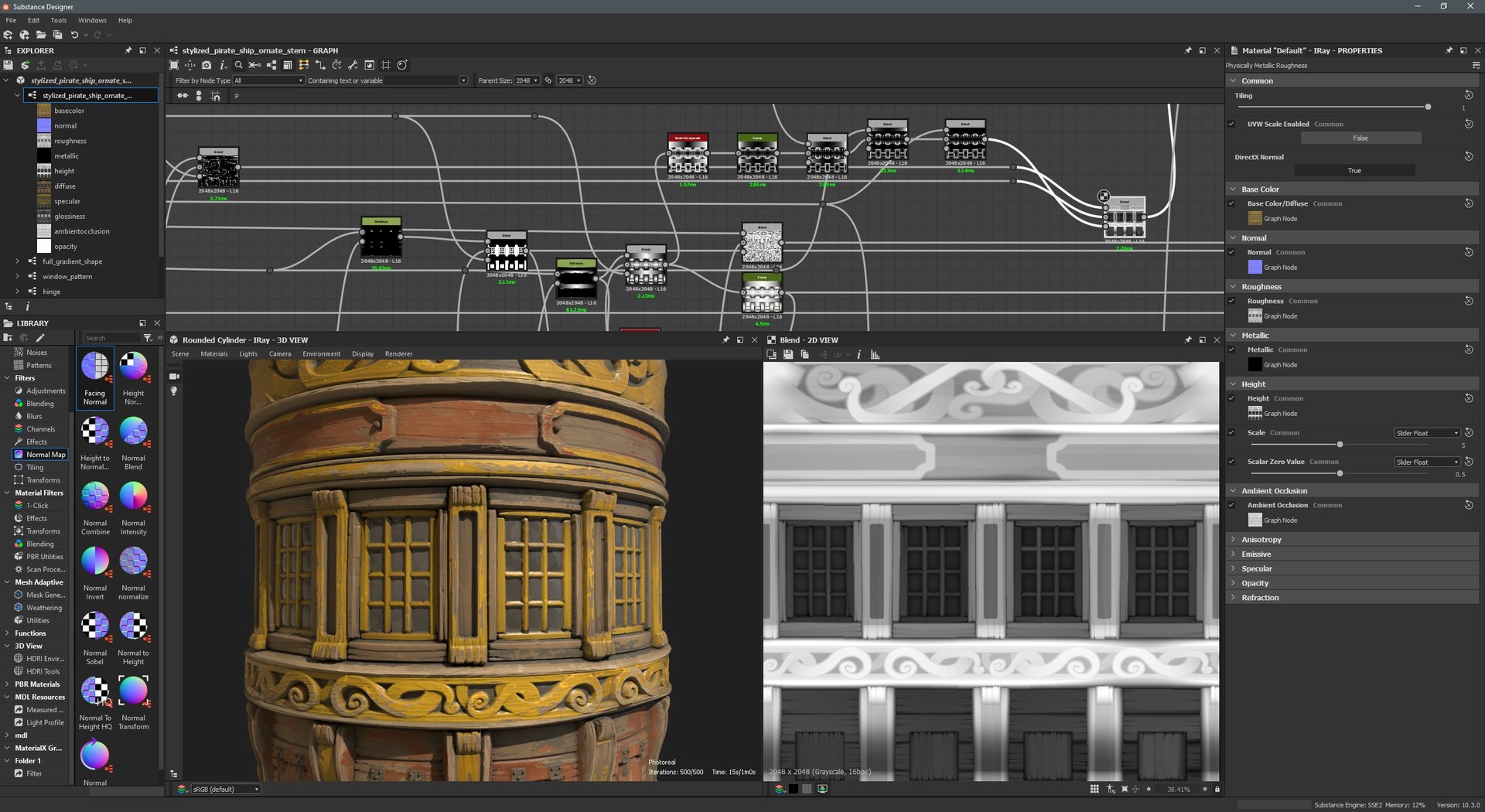- Substance Designer 2021 Vs
- Substance Designer 2020 Torrent
- Substance Designer 2021 Trends
- Substance Designer 2019
- Substance Painter
- In this video we take a look at Substance in 3ds Max. This is an updated video covering the plugin for 2021. Please check the Substance in 3ds Max documentat.
- Substance Designer is the industry's reference Material Creation and Scan Processing Tool. More than 95% of AAA game projects currently in development use Substance as well as the most prestigious visual effects and animation studios.
- For Substance, a new Substance2 map has been developed that is faster and uses the most recent Substance engine for native sbar file loading – that is, exporting maps from Substance Designer is no longer necessary. Substance tools also support textures up to 8K with support for the renderers included with 3ds Max - Arnold, ART, Scanline.
- I'm looking at picking up Substance Painter 2021 as I don't actually have any versions of Painter available to use currently, and am finding that a lot of projects I want to do would greatly benefit from it. I already have an older version of Designer, though. Substance Designer 5.
Today is a special day. Substance Source becomes the perfect home for a (gigantic) batch of new materials. The title clued you in: it’s all about buildings! And we might possibly have gone way over the top this time.
Entries close 16th January 2021. Winners announced 26th January 2021. Dates mentioned are at 11:59 pm on the date in question. All dates are based on GMT. No modifications are allowed to the provided model. You must use Substance apps (Substance Painter, Substance Designer or Alchemist). You must share your progress.
There are full building facades, structural construction materials, interior design and decoration textures, so there’s a chance the material of your dream is in here. And if it’s not, don’t forget to check last year’s collection of powerful assets designed especially for Archviz experts.
Welcome to Parametric City!
Last year, we created parametric materials to simplify the texturing of building elements, like curtain walls and windows. This time, we went even further: the material is the facade.
The material acts as a tileable portion of the building that can be repeated across the face of your 3D model. You just need to make a few decisions: choose the number of floors, the number of windows per floor, and in no time, an entire city block erects. No need to model the facade details: a simple geometry is enough.

We know that the creation of detailed neighborhoods requires a lot of resources and time that Archviz experts just can’t afford. And in the meantime, the Sims™ need a place to live!


In the end, what we want is to give you the ability to save extensive modeling time, and quickly generate realistic facades for secondary buildings. These skylines that will appear in the background shouldn’t take too much time away from the main building of the scene.
However, the need for speed of execution should in no way drive you to sacrifice photorealism and creative freedom. The facades are fully parametric, meaning that every aspect can be changed. From the material of the walls to the proportion of the windows, their color — even the lintel design and the ledges at every story: everything adapts to your need and taste.
And to truly give the illusion of realism, your building needs to feel inhabited, and that means finding a way to infer the life that is happening behind the curtains.
The parametric facades includes parameters to selectively vary the details of each window. You can decide to open or close the curtains, roll down the shutters, and choose between daylight or night-time mode to get a completely randomized final result.
Technical materials make their entrance into the collection to inspire new interiors for 2021. Form meets function with these elements designed with performance in mind only. Industry secrets, such as aeronautics technical materials, are making a noticed entrance into interior spaces.
Space separations, walls or ceilings become ever-changing surface according to the time of day and the viewers position. You can apply it to full wall sections, or divide it in smaller tiles and brick-like layouts to introduce a graphic second read. See how it works with these translucent plastic partitions:
In the same vein, expended foams that were hidden behind walls become visual mechanics. We designed several types foam materials with parameters to let you customize the cells size, depth, color and density.
Substance Designer 2021 Vs

Metal foams are a cellular structure consisting of a solid metal with gas-filled pores comprising a large portion of the volume. The pores can be sealed or interconnected. Metal foams are lightweight, have exceptional mechanical resistance, and provide sound and thermal insulation.
Plastic foams are a type of polymers which include void and cells within the polymer. This cellular structure forms by impregnation of a physical or chemical blowing agent. Also called “expanded plastics”, foams possess inherent features that make them suitable for shock absorption, thermal and sound insulation, even captation of interior ambient pollution. They are also very easy to form cut and assemble.
Ceramic foams are astonishingly lightweight, while sharing the desirable visual qualities of ceramic.
Complementary to real marble and stone finishes, acrylic polymer primarily serve as a countertop and benchtop surface, though it has many other applications. It is suited for sinks, bowls, basins, baths and shower trays; creative planners have all the options to design functional and tasteful kitchens and bathrooms, sanitary facilities, and much more.
Unlike stone, acrylic polymers allow for the widest range of shapes imaginable. A delicate composition of acrylic, minerals, and natural pigments combine to create a smooth, non-porous, thermo-formable, and visually seamless surface. The parameters offer a wide range of options. The color slider alone will let you generate entire catalogs of shades for any style of countertop.
When it comes to surface design trends, there’s one look that’s evergreen on both residential and commercial interiors alike: natural stone effects. With inclusions of terrazzos or veins, like with marble, natural stone is timeless. But it’s not just floor surfaces that have taken this style to heart. From tabletops and bathroom basins to phone cases and stationery, this trend is everywhere and it’s a look with longevity.
Speaking about evergreen materials, this release also feeds your palette of finishes and patterns. When it comes to interior design, one can never have too many woods, marbles and concretes. Of course, it’s all totally sustainable as everything’s digital !
We don’t compromise on realism: every material mimics how the fabric of material behave in real life. Take wood for instance, the way you cut the trunk will give you a different finish of the fibers… but more on this later. This goes, of course, for every part of the transformation process: from fabrication to installation and every step in between.
We created materials with parameters that enable anyone to become a material expert by playing with the main visual attributes of the texture file.
Substance Designer 2020 Torrent
For the more curious, the .sbs files are all on Substance Source if you wanted to know how the effects are made. You could definitely get some inspiration there! We also aim for the library to become a digital bible for material procedural creation. The nodal graphs are at your disposal to generate your personal catalog of finishes.
So. It’s raining wood on Substance Source. You asked for it! Today you get access to a whopping 1000 fully parametric woods splintered into:
– 40 unique wood types
– 5 main wood finishes
– 25 layout of wood floors
– 10 wood siding, dock and roof shingle patterns
– laser carved wood patterns
If you want to be more experimental, there’s even a couple of wood composites we picked up from a previous discussion with Daniel Liden.
We added new metal meshes and decorative woven structures. Parametric woven metal patterns consist of fl at and/or round wires interwoven to create distinctive textures and designs for wall partition systems or ceiling tiles.
Finally, we couldn’t end this collection without speaking about concretes and marbles. The materials are completely ubiquitous in modern architecture – for good taste and deep pockets! Check out these beautiful concrete walls:
Substance Designer 2021 Trends
Many of you in the community requested more photorealistic marbles and were kind enough to share some references, so we made the most of the opportunity. Slabs and blocks of marble are used for stair treads, floor tiles, facing stone, cemetery stones, window sills, ashlars, sculptures, benches, paving stones and many other uses.
Substance Designer 2019
Check out a selection of free materials from the architectural release on Substance Source!
Substance Painter
Artwork and visuals by the Substance Source team: Maximilien Vert, Eric Lautard, Damien Bousseau.
